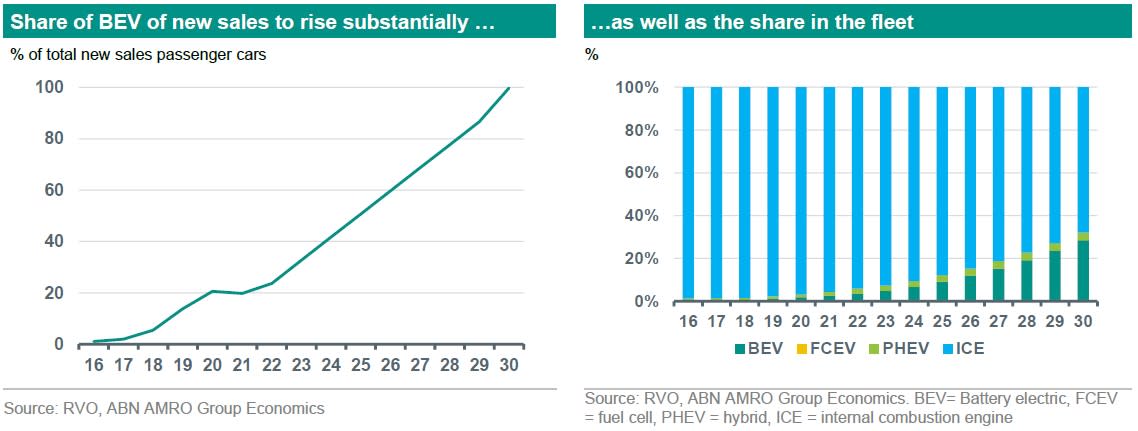SustainaWeekly - The challenge of reducing car emissions


In this edition of the SustainaWeekly, we start by zooming in on the transition of the car sector in the Netherlands, which accounts for around a tenth of all greenhouse gas emissions. We assess the current challenges and where emissions are heading given current policies. We go on to analyse the carbon footprint of issuers in the logistic real estate sector and whether differences are visible in their bond pricing. Finally, we take a closer look at the green utility hybrid space.
Economist: The share of zero-emission passenger cars and charging points rose considerably in 2022. However, they need to continue to rise substantially to meet government targets for 2030. On current policies, the expected GHG emission reduction for cars in 2030 falls short of what is needed.
Strategist: Logistic real estate generally has a lower carbon footprint than retail real estate, though disclosure of energy performance (and carbon emission) is lagging at various EUR IG logistic real estate names. Although Prologis and PELF stand out in terms of energy performance, this is not (yet) visible in their bond pricing.
ESG Bonds: Issuers of green utility hybrids operate with a decent buffer in their credit metrics in the majority of cases. Utility hybrids offer attractive spreads in comparison to their senior equivalent, and there are many green hybrid bonds which also have a significant carbon reduction impact.
ESG in figures: In a regular section of our weekly, we present a chart book on some of the key indicators for ESG financing and the energy transition.
More needed to bring down emissions of cars
Share of zero-emission passenger cars and charging points have risen considerably in 2022…
…and they need to continue to rise substantially to meet government targets for 2030
The expected GHG emission reduction for cars in 2030 falls short of what is needed
Introduction
In 2021 the mobility sector in the Netherlands was responsible for 30.8 Megaton of greenhouse gas (GHG mostly CO2). This represented 18% of the total greenhouse gas emissions in 2021. The preliminary data for 2022 show that greenhouse gas emissions for 2022 could decline to 30 Megaton. Within mobility, road transport is the biggest emitter. It is responsible for around 85% of the total emissions of the mobility sector. Passenger cars emit around half of the total of mobility. The government target for the mobility sector is to reduce GHG emissions to 21 Megaton in 2030. It is clear therefore that to bring down greenhouse gas emissions the mobility sector needs to play a significant role.
Share of zero-emissions cars needs to continue to rise substantially
The Dutch government’s policy is that every new car sold from 2030 onwards has to be a zero-emission car. This can be battery electric car or a hydrogen fuel cell electric car. At the end of December 2022 the car fleet was around 8.8 million passenger cars and 306,321 new passenger cars were sold in 2022, far below the annual average of around 440,000 (average 2005-2021). The fleet of battery electric cars in the Netherlands stood at 328,295 passenger cars and 596 fuel cell electric cars at the end of December 2022 (). This is an increase of 34% in battery-electric vehicles. In 2030 the amount of zero-emission new passenger cars should be equal to the now total sold new passenger cars of around 440,000. To get there, the share in sales of zero-emission passenger cars needs to rise substantially from 23.6% in 2022 () to 100% in 2030 (see graphs below).
The Netherlands has more ambitious targets for cars than the EU. The EU has set a zero-emission target for both new cars and vans by 2035, against 2030 for the Netherlands. The share of battery-electric cars in the European Union in 2021 was only 0.8%. There were 246 million cars on the road in the EU in 2021 (ACEA). In the EU 12.1% of the new cars sold in 2022 was battery electric, while this share was 24% in the Netherlands. So the Netherlands is well advanced compared to the EU.
Worldwide more than 10 million EVs were sold in 2022. Of that total, 70% were full battery EVs, with the rest being plug-in hybrids (IEA). According to the IEA the share of EVs in total car sales in the net-zero scenario should reach over 60% in 2030. In this scenario, the number of EVs worldwide jumps from 60 million in 2021 to over 700 million in 2030.
In the Netherlands, the fleet of 8.8 million passenger cars was responsible for roughly 15.4 Megaton greenhouse gas emissions in 2021. In 2030 the fleet of cars that emit greenhouse gasses is expected to be 6.4 million passenger cars (internal combustion and hybrid vehicles). The total greenhouse gas emissions of these 6.4 million passenger cars will likely be around 11.6 Megaton. So, by introducing the measure that all new passenger cars in 2030 have to be zero-emission cars, greenhouse gas emissions will probably drop from 15.4 megaton to 11.6 megaton or a reduction of 3.8 megaton by 2030. Other road transport also needs to reduce CO2 emissions. We will focus on commercial road transport and heavy-duty transport in an upcoming note in this publication.
Total cost of ownership battery electric cars versus internal combustion cars
Currently battery electric cars are more expense to buy even considering government subsidies. The average purchase costs in 2021 was EUR 51,000 while the average price of a petrol car was around EUR 10,000-15,000 lower. However, according to a recent study from electric vehicles in nearly every segment and in nearly every European country are now at the same price or cheaper than petrol or diesel cars. The analysis is based on the total costs of owning and operating a car (TCO) including energy/fuel, depreciation, tax, interest, insurance and maintenance. The study notes that “fuel costs remain significantly lower for electric cars than petrol and diesel cars: fuel costs represent 15% of the total cost of ownership of an EV, while this is 23% and 28% for petrol and diesel drivers. So battery electric vehicles have a higher initial investment but lower running costs …”. The government incentive program covers some of this higher initial investment. For example the subsidy for buying a new electric car is EUR 2,950 and for a used electric car EUR 2,000 (the amounts for 2023). To achieve the goal of getting more zero-emission passenger cars on the road, purchase costs will have to fall so that electric driving becomes accessible to a large number of people.
Substantial increase in the number of charging points
The total number of charging points in the Netherlands increased substantially, to 119,197 in December. This is an increase of 44% compared to 2021. At the end of 2021 there were 1.8 million charging points worldwide (IEA). In the Netherlands, there are 69,804 regular public charging points that are 24/7 publicly accessible, 49,393 semi- regular semi-public charging points and 4,164 fast charging points. Regular charging points (public and semi-public) have smaller or equal than 22kW capacity while fast charging points have larger than 22 kW (). There are also an estimated 345,000 private charging points. The RVO published a survey on charging in the Netherlands (National Laadonderzoek). According to this survey, 68% of electric car users have solar panels and 95% of this group would like to use solar power for charging or are already doing so.
Currently there are 4.1 cars (BEV, PHEV) per public and semi-public charging points. If we also consider the private charging points then there are 1.1 cars per charging point. In China this is 5 cars per charging point and in Germany 12 cars per charging point. So looking at other countries the number of charging points should currently be enough. However, in densely populated areas where there is also limited possibility for private charging points it is likely that the number of cars (BEV, PHEV) per charging point is much higher and that there are not sufficient charging points. The government aims to have 1.8 million public, semi-public and private charging station in 2030. Currently there are 10 hydrogen fuelling stations. This means around 60 fuel cell cars per fuelling station.
Conclusion
In 2021 the mobility sector in the Netherlands was responsible for 30.8 Megaton of greenhouse gas (GHG) emissions including 30.1 megaton CO2 emissions. In 2022 this was most likely lower. This was 18% of the total greenhouse gas emissions. Road transport is the biggest emitter. It is responsible for around 85% of the total emissions of the mobility sector. Passenger cars emit around half of the total of mobility. The government has set a target that all new passenger cars need to be zero-emission cars in 2030. This is an ambitious target that will likely result in a reduction of around 4 Megaton of greenhouse gas emissions in 2030. This falls short of what is needed. Cars should reduce a total of 5 Megaton of greenhouse gas emissions 2030. A faster uptake of EVs via stimulus measures, more affordable EVs and more stringent emission targets for internal combustion cars are crucial to bring down emissions at a faster pace. The target of the mobility sector is a reduction of 10 Megaton greenhouse gas emissions in 2030. More needs to be done in the other parts of the mobility sector to bring down these emissions. We will focus on this in future notes.
